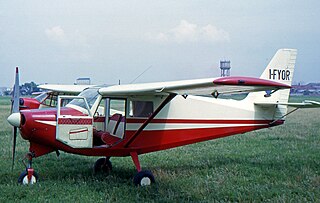Related Research Articles

The IMCO CallAir A-9 is a small agricultural aircraft that first flew in 1962, a development of the company's previous successful crop-dusters. It is typical of aircraft of its type - a single-seat aircraft with a low wing incorporating spraying gear.

The Aero Boero AB-95 is a small Argentine civil utility aircraft that first flew on March 12, 1959. It was built by Aero Boero S.A. of Córdoba. The AB-95 is a conventional high-wing monoplane built of fabric-covered metal structure. It has fixed undercarriage.

The Aero Boero AB-115 is an Argentine civil utility aircraft. It was developed from the AB-95-115, a refined AB-95 with a more powerful engine and improved aerodynamics. Specific differences included wheel spats, a redesigned engine cowling molded of fiberglass, and aluminum ailerons and flaps.

The Aero Boero AB-180 is an Argentine civil utility aircraft, a substantially improved development of the AB-95. It featured a more powerful engine and incorporated the aerodynamic changes made on the AB-115 and improved on them. The first example flew in 1967 and was in production until 2000.
The Aero Boero AB-210 is an Argentine civil utility aircraft, a development of the AB-180 with improved performance delivered by a fuel-injected engine. Unlike previous aircraft by this manufacturer, it also featured tricycle undercarriage, but retained the same general high-wing configuration. Only a single prototype was built, first flying on 22 April 1971.
The Aero Boero 260AG is an Argentine agricultural aircraft that first flew in 1973. Despite the similarity in designation, it is completely different from and unrelated to the Aero Boero AB-260.
The Aerocar II Aero-Plane was an unusual light aircraft flown in the United States in 1964. It was a development of designer Moulton Taylor's famous Aerocar roadable aircraft, but was not roadable itself. Rather, it used the wings and tail unit designed for the Aerocar and mated them to a new fibreglass cabin. The weight saved by not including the parts needed to make the vehicle driveable on the ground meant that an additional two passengers could be carried. Only a single example was built.

The Aero Commander 100, various models of which were known as the Darter Commander and Lark Commander was a US light aircraft produced in the 1960s. It was a high-wing monoplane of conventional design, equipped with fixed tricycle undercarriage.

The Cessna T303 Crusader is an American six-place light twin-engined aircraft built by Cessna Aircraft Company. Production ceased in 1986.

The Rutan VariViggen is a homebuilt aircraft designed by Burt Rutan. The aircraft is a tandem two-seater of primarily wooden construction with a delta wing and a canard foreplane. The VariViggen is powered by a 150 hp Lycoming O-320 aero engine in pusher configuration. The prototype was designated Model 27, and the production version was Model 32.

The Fuji FA-200 Aero Subaru is a single-engine piston-powered monoplane built by Fuji Heavy Industries of Japan.

The Valmet PIK-23 Towmaster or Suhinu is a Finnish two-seato glider towing/primary trainer aircraft built entirely out of composite materials in the early 1980s.

The Aero-Flight Streak was an American two-seat light aircraft built in 1946 by Aero-Flight Aircraft Corporation at Buffalo, New York. Advanced for its time, it was of all-metal construction with tricycle undercarriage, and accommodated the pilot and passenger in tandem beneath a sliding, bubble canopy.

The Caproni Vizzola C22 Ventura was a light jet-powered aircraft developed in Italy for use as a military trainer. It was of conventional sailplane configuration and bore a family resemblance to the Caproni Calif gliders, although the Ventura had an almost entirely metal structure. The student and instructor sat side by side under an expansive canopy, and weapons hardpoints were provided under each of the slender, high-mounted wings. It had retractable, tricycle undercarriage.

The Focke-Wulf A 20 Habicht was an airliner developed in Germany in the late 1920s. It was a high-wing cantilever monoplane with fixed tailskid undercarriage. The fuselage was deep and seated four passengers in a fully enclosed cabin. The type was not bought by the airlines and only a few examples were built.

The IAR-827 was an agricultural aircraft built in Romania in the 1970s and 1980s. The penultimate member of the family of designs that began with the IAR-821, it was, like the others, a conventional low-wing monoplane with fixed, tailwheel undercarriage, and shared the all-metal construction of the IAR-826. The prototype flew in 1976, powered by a Lycoming IO-720 engine, but the production examples that followed all had the PZL-3S.

The Partenavia P.57 Fachiro is an Italian, four-seat, high-wing, touring monoplane, fitted with a fixed tricycle undercarriage.
The Zenair Mono-Z CH 100 is a single-seat, single-engined Canadian light aircraft of the 1970s. It is a smaller version of the Zenair CH 200 with a less powerful engine, which was sold as a homebuilt aircraft by Zenair.

The Aircraft Technologies Acro 1 is an American aerobatic homebuilt aircraft that was designed by Fred Meyer and produced by Aircraft Technologies of Lilburn, Georgia. When it was available the aircraft was supplied as a kit or in the form of plans for amateur construction. Neither plans nor kits are available anymore and the aircraft is out of production.
The Zenair CH 180 Super Acro-Z is an aerobatic light aircraft built by Zenair in the 1980s.
References
- Notes
- Bibliography
- Taylor, John W.R. (1982). Jane's all the World's Aircraft 1982–83. London: Jane's Yearbooks. ISBN 0-7106-0748-2.
| This article on an aircraft of the 1960s is a stub. You can help Wikipedia by expanding it. |